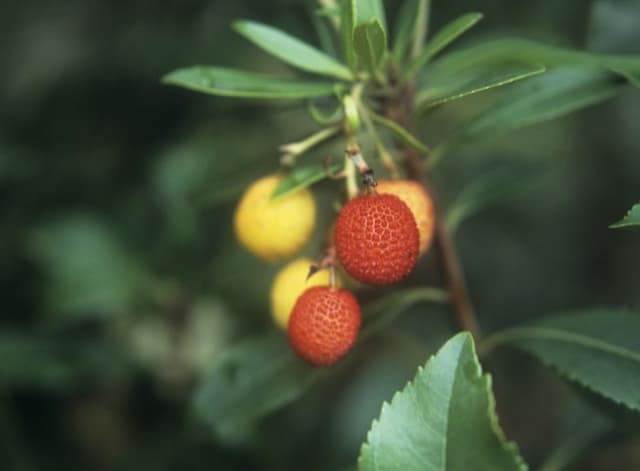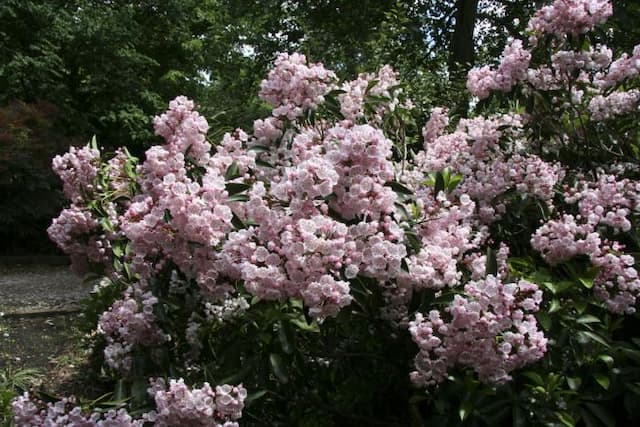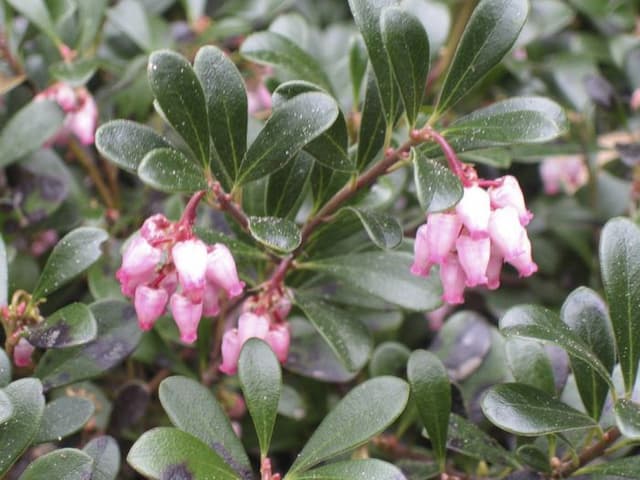Glaucous Blueberry Vaccinium glaucoalbum

ABOUT
This plant, commonly known as the white berry blue honeysuckle, is characterised by its distinctive foliage and fruit. The leaves present a blue-green hue, often with a frosted or glaucous appearance which gives it a somewhat silvery look. The leaves are broad, with a smooth edge, and they usually grow alternately along the branches, creating a lush and somewhat dense canopy. The flowers of the white berry blue honeysuckle are delicate and often bell-shaped, ranging in color from a soft white to a pale pink. These blossoms can be found dangling from the branches in clusters, which makes them quite attractive when the plant is in bloom. Perhaps the most noteworthy feature of this plant is its fruit. The berries it produces are a striking powdery white or blue-white, and they stand out against the foliage for their unique coloration. These berries are small and round, usually with a slightly flattened end. All these features combine to create a plant that is both ornamental and practical, as the fruits are not only beautiful to look at but are enjoyed by wildlife and can be edible for humans as well. The overall impression of the white berry blue honeysuckle is one of a robust and attractive plant that can catch the eye whether in flower or fruit.
About this plant
 Names
NamesFamily
Ericaceae
Synonyms
Glaucous Blueberry, Blueberry Huckleberry, Pale Blueberry
Common names
Vaccinium nummularia, Vaccinium poasanum.
 Toxicity
ToxicityTo humans
The Vaccinium glaucoalbum, commonly known as the Glaucous Blueberry, is not widely recognized as a poisonous plant to humans. Generally, species within the Vaccinium genus, which includes blueberries, cranberries, and huckleberries, are not toxic and are in fact commonly consumed. However, as with any plant, individuals may have allergies or sensitivities that could cause adverse reactions. If this particular species or an unidentified wild berry is ingested and symptoms of an allergic reaction or poisoning occur—such as nausea, vomiting, diarrhea, or skin irritation—medical attention should be sought.
To pets
The Vaccinium glaucoalbum, known as the Glaucous Blueberry, is not commonly known to be toxic to pets. Species in the Vaccinium family are often considered safe for dogs, cats, and other domestic animals. However, it is always important to exercise caution and prevent pets from consuming large quantities of any non-familiar plants or wild berries. In the instance where a pet ingests a large amount of Glaucous Blueberry or shows signs of an adverse reaction—such as vomiting, diarrhea, or signs of distress—it is advisable to consult a veterinarian.
 Characteristics
CharacteristicsLife cycle
Perennials
Foliage type
Evergreen
Color of leaves
Varies
Flower color
White
Height
1-2 feet (30-60 cm)
Spread
1-2 feet (30-60 cm)
Plant type
Shrub
Hardiness zones
7
Native area
Asia
Benefits
 General Benefits
General Benefits- Nutritional Value: The Vaccinium glaucoalbum, commonly known as billberry, produces berries that are rich in vitamins, minerals, and antioxidants.
- Wildlife Habitat: The billberry plant can serve as a habitat and a source of food for various wildlife species, including birds and mammals.
- Landscape Aesthetics: With its attractive berries and foliage, billberry can enhance the visual appeal of natural landscapes and gardens.
- Erosion Control: Billberry plants can help prevent soil erosion due to their root systems that stabilize the ground.
- Cultural Significance: In some regions, billberry has cultural importance and is used in traditional festivals and cuisines.
 Medical Properties
Medical Properties- Antioxidant: Vaccinium glaucoalbum, commonly known as the White-fruited Blueberry, is believed to have antioxidant properties due to the presence of anthocyanins and other polyphenolic compounds.
- Anti-inflammatory: The plant might have compounds that reduce inflammation, helping in conditions associated with inflammatory responses.
- Antidiabetic: There is limited evidence suggesting that White-fruited Blueberry might help in regulating blood sugar levels, possibly due to its fiber content and phytochemicals.
- Cardioprotective: Some studies suggest that berries, including those related to the Vaccinium genus, could potentially have heart-protective effects, possibly by improving lipid profiles and aiding vascular health.
- Visual health: Like other members of the Vaccinium family, the White-fruited Blueberry is suggested to contribute to eye health, although specific studies on this species might be lacking.
 Air-purifying Qualities
Air-purifying QualitiesThis plant is not specifically known for air purifying qualities.
 Other Uses
Other Uses- Vaccinium glaucoalbum, commonly known as the white-fruited blueberry, can be used in landscaping as an ornamental plant due to its attractive foliage and berries.
- The berries of the white-fruited blueberry can provide food for wildlife, offering a natural way to support local ecosystems.
- The plant can be used for educational purposes in botanic gardens and conservatories, demonstrating the diversity of the Vaccinium genus.
- Fruit from white-fruited blueberry can be used as a natural dye for fabrics and food, although it may not be as potent as other berry species.
- The plant can be cultivated for bonsai, with its small leaves and berries offering a unique aesthetic for enthusiasts.
- Flowers from the white-fruited blueberry might be included in floral arrangements, particularly for those seeking a rustic or wildcrafted look.
- Leaves of the white-fruited blueberry can be used in the craft industry, either pressed or fresh, for their unique texture and color.
- Due to their hardiness, white-fruited blueberry plants can be used in erosion control projects or in areas where other plants struggle to thrive.
- The branches and twigs of the white-fruited blueberry can be utilized in decorative wreaths and as part of other decorative art pieces.
- Photographers and painters may use the white-fruited blueberry plant as a subject for their work, capturing its aesthetic in various seasons.
Interesting Facts
 Feng Shui
Feng ShuiThe Himalayan blueberry is not used in Feng Shui practice.
 Zodiac Sign Compitability
Zodiac Sign CompitabilityThe Himalayan blueberry is not used in astrology practice.
 Plant Symbolism
Plant Symbolism- Longevity: The Vaccinium glaucoalbum, also known as the Blueberry, often symbolizes longevity due to its hardy nature and the longevity-associated antioxidants present in its berries.
- Wellbeing: Blueberries are known to be superfoods, so they represent good health and wellbeing.
- Abundance: Blueberry bushes produce many berries, representing abundance and fertility.
- Protection: The Blueberry plant is associated with protection since its dense thickets provide shelter and sanctuary for various wildlife.
- Youthfulness: Due to the antioxidant properties of blueberries that combat aging, the plant is often connected to the theme of maintaining youth and vitality.
 Water
WaterThe Himalayan Blueberry, Vaccinium glaucoalbum, requires consistent moisture and should not be allowed to dry out completely. Water the plant deeply once a week with about 1-2 gallons of water, depending on the size of the plant and soil drainage. During hot, dry periods, the frequency may increase to twice a week to maintain moist soil. It's important to avoid overwatering, which could lead to root rot, so adjust the amount based on rainfall and soil conditions.
 Light
LightHimalayan Blueberry thrives in partial shade to full sun. The best spot for the plant is one where it receives dappled sunlight throughout the day or full morning sun with some afternoon shade. Avoid placing it in deep shade, as this can reduce fruiting and lead to a leggy growth habit.
 Temperature
TemperatureFor Himalayan Blueberry, the ideal temperature range is between 60-75°F. It can survive minimum temperatures of around 20°F, making it suitable for USDA zones 7-9. Avoid exposing the plant to temperatures over 85°F for extended periods as this may cause stress.
 Pruning
PruningPrune the Himalayan Blueberry in late winter or early spring before new growth begins. This promotes healthy growth, prevents overcrowding, and encourages fruit production. Remove any dead or diseased branches, thin out older stems, and cut back excessive growth. Pruning yearly helps maintain plant shape and vigor.
 Cleaning
CleaningAs needed
 Soil
SoilThe best soil mix for the Himalayan blueberry (Vaccinium glaucoalbum) is well-draining, acidic, with a pH range of 4.5 to 5.5. A blend of peat moss, pine bark, and perlite or sand is suitable for maintaining the necessary conditions.
 Repotting
RepottingHimalayan blueberry plants should be repotted every 2 to 3 years to refresh the soil and accommodate root growth, ensuring careful handling to minimize root disturbance.
 Humidity & Misting
Humidity & MistingHimalayan blueberry plants prefer moderate to high humidity levels, ideally between 50% and 80%, to mimic their native montane forest conditions.
 Suitable locations
Suitable locationsIndoor
Provide bright light, acidic soil, and maintain humidity.
Outdoor
Choose a sunny spot, use acidic soil, keep moist.
Hardiness zone
7-9 USDA
 Life cycle
Life cycleVaccinium glaucoalbum, commonly referred to as the blueberry, begins its life cycle with seed germination, typically after a period of cold stratification simulating winter, which breaks seed dormancy. Following germination, seedlings emerge and enter a juvenile vegetative stage, developing roots, stems, and leaves, but not yet producing fruit; this stage can last several years. As the plant matures, it enters the reproductive stage, characterized by the formation of flowers that are pollinated by insects like bees, resulting in fruit set. Blueberries then develop from the flowers, starting as green berries, which ripen to a blue or purple color indicating readiness for harvest. After fruiting, the plant enters a period of dormancy, especially in colder climates, where it withstands winter before resuming growth the following spring. This annual cycle of growth, reproduction, and dormancy continues throughout the life of the plant, which can live and be productive for many years.
 Propogation
PropogationPropogation time
Spring-early summer
The most popular method of propagating Vaccinium glaucoalbum, also known as Alpine Blueberry, involves taking semi-hardwood cuttings during the summer months. To do this, select a healthy, disease-free branch and cut a 4 to 6-inch (10 to 15 cm) length that includes several leaf nodes. Strip the leaves from the bottom half of the cutting and dip the cut end into a rooting hormone powder to encourage root development. Plant the cutting in a moist, well-draining soil mixture, ensuring that at least two leaf nodes are below the soil surface. Place the pot in a location with indirect sunlight and maintain consistent moisture. Roots typically develop within a few weeks to a couple of months, after which the new Alpine Blueberry plant can be transplanted to a more permanent location.









